A newly resurfaced pool deck frequently represents the pinnacle of backyard aesthetics; however, neglecting its maintenance can transform this inviting space into a potential safety hazard. Seasonal maintenance is not merely a routine task; it is critical for ensuring safety and extending the longevity of your investment.
We have compiled a comprehensive checklist detailing the most effective tools and essential steps that should not be overlooked to help you maintain your pool deck in impeccable condition. Are you prepared to make your deck the envy of your neighbors? Continue reading for further insights.
Why Is It Important to Maintain Your Newly Resurfaced Pool Deck with Proper Maintenance?
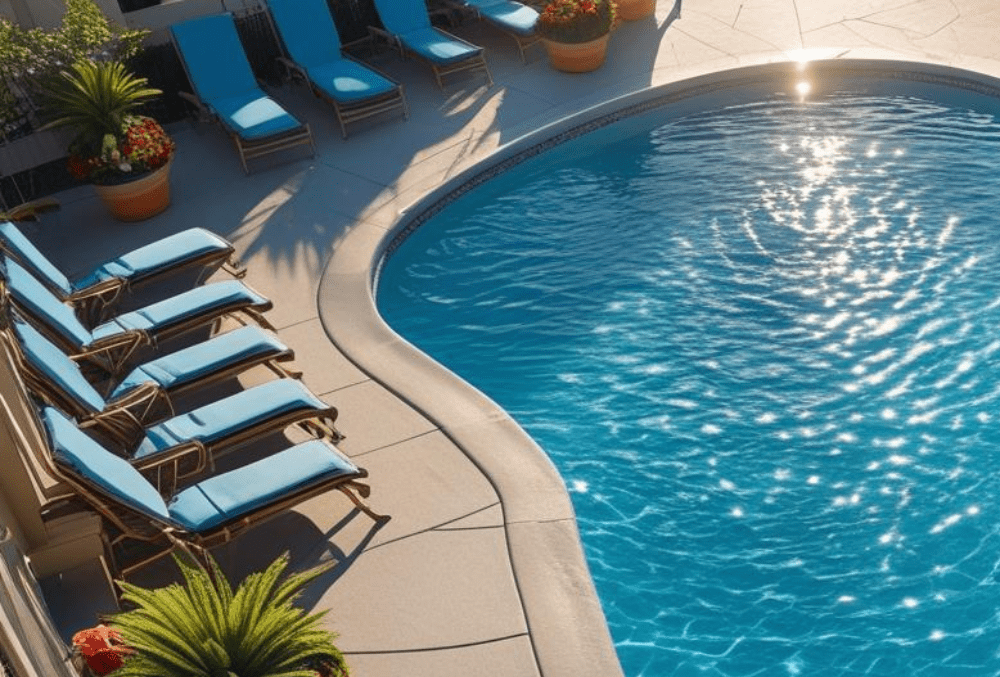
Maintaining a newly resurfaced pool deck is essential not only for aesthetic appeal but also for ensuring longevity and safety for all users.
A well-maintained deck helps to prevent structural issues that may arise from exposure to water and weather elements, thereby safeguarding pool owners from costly repairs and enhancing the overall pool experience during summer gatherings.
Implementing regular cleaning techniques is crucial for removing debris and preventing algae growth, while also ensuring that water chemistry remains balanced and includes routine shock treatment, contributing to a safe swimming environment.
When Is the Best Time to Perform Seasonal Maintenance?
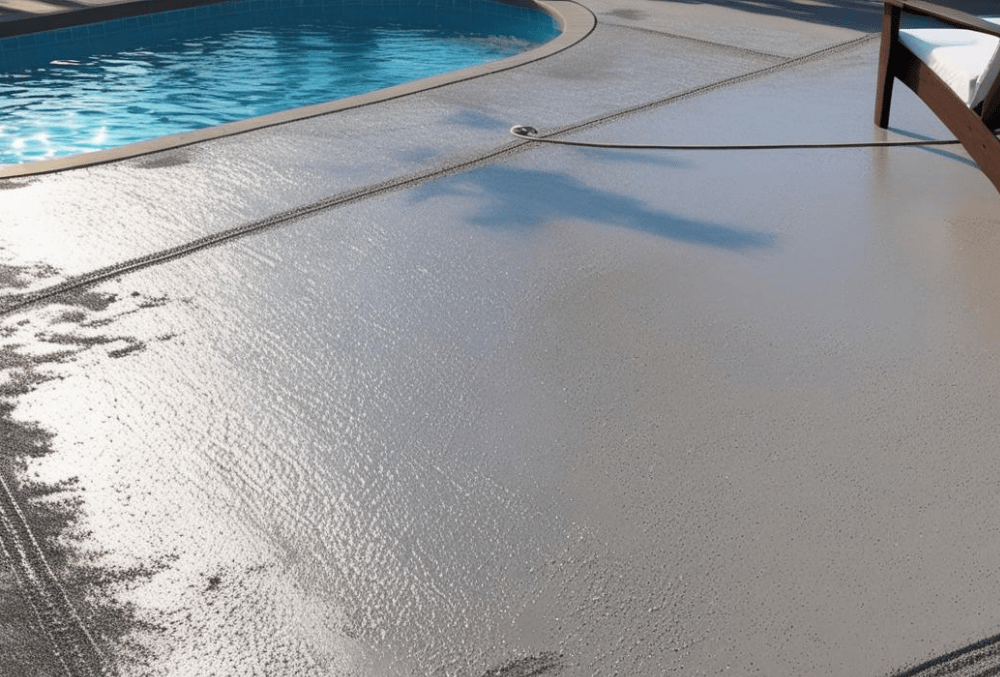
The optimal time to conduct seasonal maintenance and repair cracks on a pool deck aligns with the changing seasons, ensuring that the pool remains safe and functional throughout the year.
To achieve this effectively, the pool owner should establish a structured maintenance plan that encompasses all four seasons. This approach facilitates the management of essential tasks that contribute to the longevity and safety of the pool.
Spring is an ideal season for a comprehensive inspection and cleaning, including the removal of debris and an assessment of equipment, ensuring cracks or damages are addressed with a spring checklist.
During summer, maintenance activities should focus on regular cleaning techniques, including skimming the surface, vacuuming the pool bottom, inspecting pool equipment, and testing water chemistry with a pool testing kit to ensure proper chemical balance.
As fall approaches, preparations for winterizing the pool become critical. This process involves applying a pool cover to protect the pool during the colder months, using winter algaecide, and conducting emergency checks to prevent potential damage, thereby ensuring safety and functionality for the upcoming swimming season.
What Tools and Materials Do You Need for Maintenance?
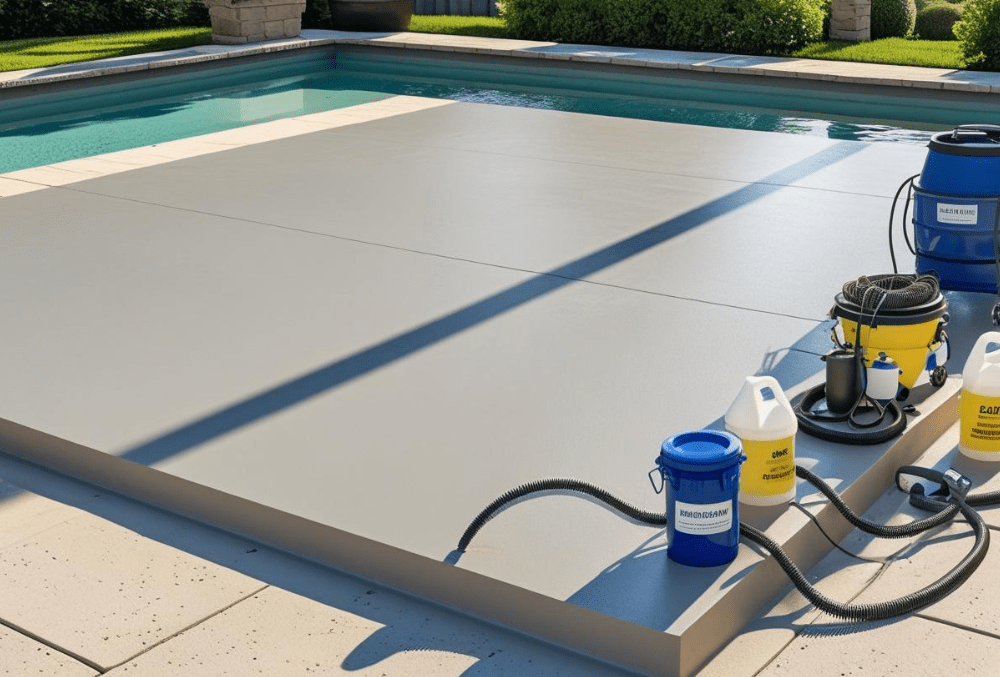
To effectively maintain a pool deck, it is essential to utilize a variety of tools and materials, including sealing products and outdoor mats, to ensure that all cleaning and repair tasks are performed efficiently.
A pressure washer is invaluable for deep cleaning, while a soft bristle brush and a specialized pool deck cleaner are effective in addressing stains without causing damage to the surface. Regular power washing helps in maintaining a clean pool environment.
Furthermore, it is important to wear safety gear, such as gloves and goggles, during maintenance activities to protect against harsh chemicals and debris.
Additionally, tools like a pool skimmer play a crucial role in regular cleaning by removing loose debris and preventing the growth of algae.
Pressure Washer
A pressure washer serves as a crucial instrument for pool maintenance, facilitating the efficient cleaning of the pool deck and surrounding areas. It employs high-pressure water jets to eliminate dirt, grime, and algae growth that conventional cleaning methods may not adequately address.
This powerful device operates by forcing water through a narrow nozzle at high velocities, significantly enhancing its cleaning capabilities. For individuals seeking to improve their pool maintenance routine, comprehending the specific advantages of utilizing a pressure washer can be highly informative.
Not only does it contribute to a cleaner environment around the pool, but it also promotes safety by minimizing slippery surfaces caused by algae and debris.
Soft Bristle Brush
A soft bristle brush is highly recommended for the maintenance of pool decks, as it efficiently removes dirt and algae without causing scratches or damage to newly resurfaced surfaces.
Regular use of this tool ensures that every corner remains free from debris, thereby preserving the pristine condition of the pool deck and enhancing safety and comfort for swimmers.
It is advisable to utilize the soft bristle brush at least once a week, particularly during peak swimming season or following heavy rainfall, to prevent the accumulation of grime.
Pool Deck Cleaner
Utilizing a specialized pool deck cleaner is essential for effectively addressing and preventing algae growth on your pool deck, while also ensuring a clean and safe environment for swimmers.
Various types of pool deck cleaners are available, each formulated with specific ingredients that target different types of dirt and contaminants. For example, some cleaners contain chlorine or sodium hypochlorite, which are particularly effective against algae and mold.
Others may utilize a combination of biodegradable surfactants and enzymes that aid in breaking down organic matter.
Sealer
Applying a high-quality sealer to your pool deck is a critical maintenance measure that protects the surface from chemicals and environmental elements, thereby reducing long-term maintenance costs.
This essential practice not only enhances the aesthetic appeal of the outdoor space but also provides protection against the damaging effects of UV rays, freeze-thaw cycles, and pool chemicals. Utilizing a sealer ensures the longevity of the pool deck, preserving its structural integrity and preventing costly repairs in the future.
Types of Sealers:
- Acrylic Sealers: These are favored for their ease of application and affordability, providing a glossy finish.
- Epoxy Sealers: Recognized for their durability, they are particularly suitable for high-traffic areas.
- Polyurethane Sealers: These offer excellent chemical resistance, ensuring surfaces can withstand harsh environmental conditions.
To achieve optimal results, it is recommended to apply sealers under moderate weather conditions, preferably in the spring or fall. Regular maintenance every 1-3 years, depending on the type of sealer used and local climate conditions, will further enhance protective measures.
Before application, it is essential to ensure the area is clean, dry, and free from debris to achieve the best adhesion and ensure lasting results.
Paint Roller
A paint roller is an essential tool for the application of protective coatings or sealers to pool decks. It ensures an even application that not only enhances durability and aesthetics but also streamlines the painting process, making it more efficient and less labor-intensive compared to traditional methods.
The selection of the appropriate roller type is critical, as different surfaces necessitate specific roller materials and nap lengths to achieve optimal results. For instance, a smooth surface may require only a short nap roller, while rougher textures could benefit from a longer nap to enable better coverage and penetration of the coating.
To utilize a paint roller effectively during summer maintenance, consider the following recommendations:
- Choose the Correct Roller Type: Opt for synthetic rollers when working with water-based paints, while natural fiber rollers are more suitable for oil-based coatings. Concrete coatings San Jose can provide additional texture and protection.
- Maintain a Steady Hand: Employ a consistent motion while rolling to prevent lap marks and ensure a smooth finish.
- Avoid Overloading the Roller: Apply the paint evenly to minimize drips and ensure appropriate layering of the coating.
Paint Tray - Essential for Winterizing Pools
A paint tray is an essential tool when utilizing a paint roller for pool deck maintenance, as it provides a convenient means to manage sealers or coatings during the application process.
The use of a paint tray not only aids in organizing painting supplies, but also plays a vital role in achieving an even application across expansive surfaces. This practical tool allows for easy loading of the roller while minimizing mess.
To optimize efficiency, it is advisable to fill the tray to a maximum of two-thirds capacity with the sealant; this ensures that the roller absorbs an adequate amount of product without becoming over-saturated.
Paintbrush - Inspect Equipment
A paintbrush is an essential tool for detail work during the maintenance of pool decks, particularly for reaching corners and edges where a roller may be insufficient.
The selection of the appropriate type of paintbrush can significantly influence the quality of the work performed. Various brush styles are designed for distinct purposes, ensuring that each maintenance task is executed with precision.
For example, angle brushes are particularly effective for achieving precise edging, while flat brushes excel in covering larger surface areas. Additionally, sash brushes are well-suited for intricate patterns or for applying paint in tight spaces.
When conducting maintenance, it is imperative to employ techniques such as light strokes and even pressure, as these methods contribute to a smooth, clean finish.
- Angle Brush: Best for corners and edges.
- Flat Brush: Suitable for large, flat surfaces.
- Sash Brush: Effective for detailed work.
Safety Gear - Essential for Seasonal Checklists
Utilizing appropriate safety gear is essential during pool maintenance to safeguard against harmful chemicals and potential injuries from tools or cleaning debris.
When undertaking the necessary tasks associated with pool maintenance, it is imperative to be adequately equipped to address the various challenges that may arise. Essential safety gear includes gloves, which protect the skin from harsh chemicals, and goggles that shield the eyes from splashes or sprays.
Furthermore, wearing non-slip footwear is critical to prevent accidents on wet surfaces.
Adhering to best practices during maintenance activities can significantly enhance safety:
- Always read labels on chemical containers meticulously and follow the manufacturer’s recommendations.
- Maintain a clean workspace to reduce the risk of slips and falls.
- Ensure adequate ventilation when using chemicals to mitigate inhalation hazards.
- Keep a first aid kit readily accessible for any minor injuries.
What Are the Steps for Maintaining Your Newly Resurfaced Pool Deck?
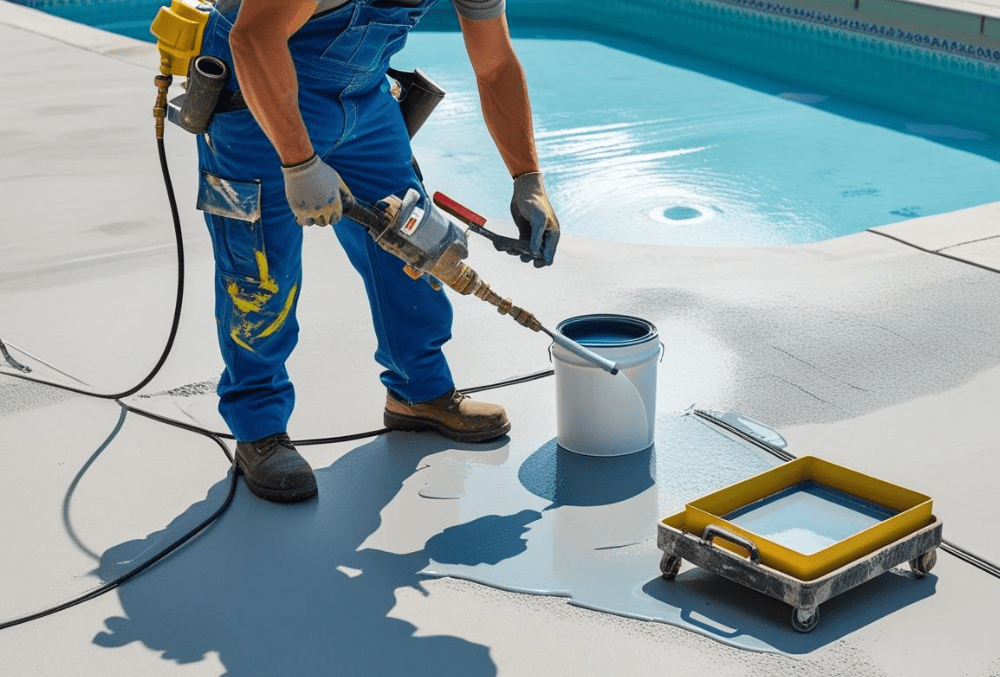
Maintaining a newly resurfaced pool deck requires a systematic approach to ensure its longevity and safety. The process begins with a comprehensive inspection to identify any potential issues, such as cracks or signs of wear.
Each step is essential in preserving the integrity of the deck, including clearing and cleaning the surface, applying necessary sealers, and performing repairs as needed. Additionally, it is important to adhere to safety measures to protect both the individual performing the maintenance and the surrounding pool environment.
Clear the Deck - Outdoor Furniture Management
The initial step in maintaining a newly resurfaced pool deck involves removing any furniture, toys, and debris to establish a safe and accessible workspace.
By eliminating these items, one facilitates a comprehensive cleaning process and enables an effective inspection of the deck’s integrity. Attention to detail during this preliminary phase can mitigate potential future maintenance issues, thereby ensuring that the deck remains in excellent condition for years to come.
Clean the Deck - Repair Pavers and Clean Filters
Cleaning the pool deck is essential for removing dirt, algae, and chemical residues, thereby ensuring a safe surface for users and maintaining the deck’s overall appearance.
Regular maintenance is crucial not only for preserving the aesthetic appeal of the pool deck but also for ensuring the safety and cleanliness of the area.
Repair Any Damage - San Jose Pool Deck Resurfacing and DIY Repairs
Repairing any damage identified during inspection, such as cracks or surface wear, is essential for maintaining the safety and integrity of the pool deck. For homeowners in the Bay Area, professional San Jose pool deck resurfacing services offer a reliable solution to restore and protect your concrete surfaces.
To ensure a comprehensive assessment, it is crucial to conduct a visual inspection of the entire deck surface, focusing on signs of deterioration or wear. This includes:
- Identifying cracks or chips that may have developed over time
- Checking for uneven surfaces that could present tripping hazards
- Assessing the condition of the surrounding drainage systems
Once potential issues have been identified, the next step is to determine the type of repairs that may be required. Minor surface cracks may necessitate simple filling, while more extensive damage could require resurfacing or, in severe cases, complete replacement.
In certain situations, it may be impractical to undertake repairs independently, particularly if structural concerns are observed or if significant sections of the deck are compromised. In such instances, engaging professionals who specialize in San Jose pool deck resurfacing is imperative.
Their expertise ensures a thorough evaluation and the application of durable, slip-resistant coatings that restore both the safety and aesthetic appeal of your pool area.
Apply Sealer - Concrete Repair San Jose
Applying a high-quality sealer to your pool deck following cleaning and repairs is essential for protecting the surface from environmental factors and extending the lifespan of the deck, as emphasized by concrete repair San Jose experts.
To achieve optimal results, it is imperative to prepare the area thoroughly before sealing, ensuring water level is appropriate. This preparation includes meticulously cleaning the surface, making necessary repairs, and allowing adequate time for any patching materials to dry completely.
It is advisable to utilize high-quality products specifically designed for outdoor flooring to enhance durability.
Apply Paint and Balance Chemicals
If the pool deck necessitates a new coat of paint, applying it after sealing will result in a vibrant finish while simultaneously protecting the underlying surface.
Selecting the appropriate type of paint is essential for achieving a durable and visually appealing outcome; acrylic paints are frequently recommended due to their flexibility and water resistance, characteristics that are particularly beneficial in poolside environments. It is imperative to prepare the surface thoroughly prior to application to ensure longevity.
Allow to Dry and Cure
Allowing adequate time for paint and sealant to dry and cure is crucial for the longevity of a pool deck. A rushed application process can result in premature wear and peeling. Adhering to these guidelines not only enhances the aesthetic appeal of the deck but also extends its lifespan.
Following the manufacturer’s specified drying times and curing processes can lead to significant cost savings on repairs over time.
How Often Should You Perform Seasonal Maintenance?
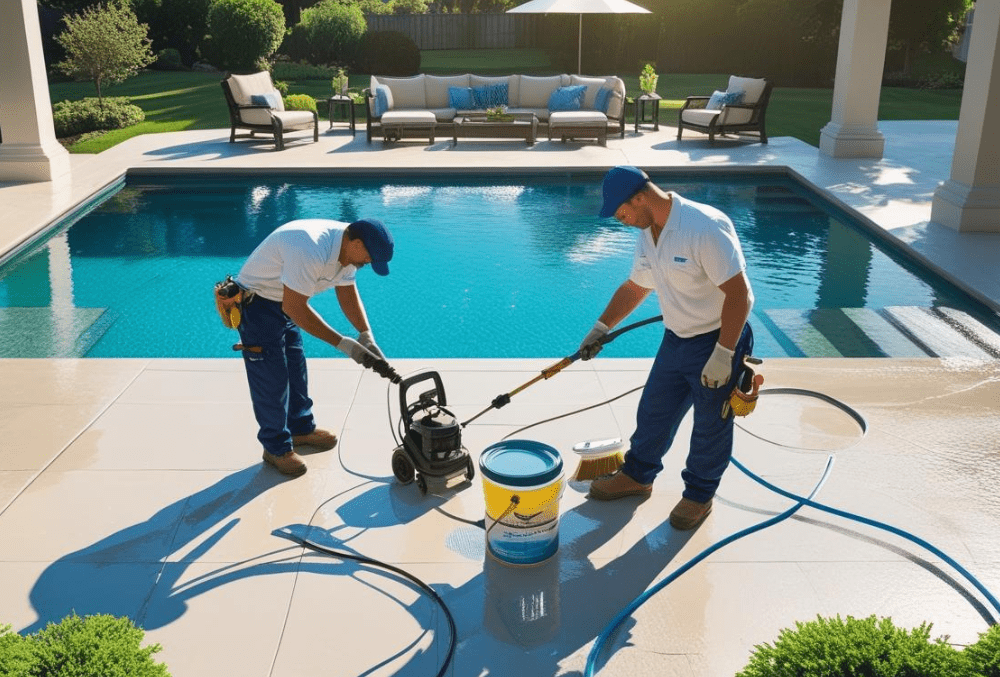
Regular seasonal maintenance is essential for prolonging the lifespan of a pool deck and ensuring a safe swimming environment. Recommended practices may vary by season.
Typically, maintenance in the spring involves thorough cleaning and inspections, while summer necessitates frequent cleaning to address increased usage and potential debris from pool parties. During the fall, preparations for winter should include securing the pool cover and inspecting the equipment.
Winter maintenance focuses on checking for damage caused by freezing temperatures and applying winter algaecide as needed.
To ensure that all necessary tasks are completed in a timely manner, maintaining a clear timeline serves as a valuable management tool. Below is a concise outline of suggested seasonal maintenance tasks:
- Spring: Remove debris, check for cracks, and inspect filtration systems.
- Summer: Clean surfaces regularly and monitor chemical levels more frequently to accommodate increased activity.
- Fall: Prepare equipment for winter by draining water, cleaning the cover, and assessing overall condition.
- Winter: Inspect for ice damage and maintain chemical balance to prevent algae growth.
What Are Some Tips for Maintaining Your Newly Resurfaced Pool Deck?

Maintaining a newly resurfaced pool deck requires a series of proactive strategies to ensure both its longevity and the safety of all users. Regular cleaning is essential to prevent algae growth and to maintain the deck’s aesthetic appeal.
Routine inspections of equipment and the pool cover, along with an assessment of the surrounding landscaping, are critical in identifying potential hazards before they escalate into serious issues. Furthermore, implementing safety measures, such as utilizing outdoor mats, can significantly enhance the safety of the area.
To optimize the upkeep of the pool deck and enhance the overall experience, consider the following actionable recommendations:
- Schedule Regular Cleanings: Establish a maintenance schedule that includes weekly cleanings, focusing on skimming debris, vacuuming, and scrubbing surfaces to combat dirt and grime.
- Inspect Equipment Routinely: Regularly check the functionality of pumps, filters, and other pool machinery to ensure efficient operation, thereby preventing costly repairs, and balance water regularly.
- Evaluate Landscaping: Assess the trees and plants in proximity to the pool area for overhanging branches or leaf litter that could obstruct drains or contribute to debris accumulation, and test water pH levels regularly.
- Implement Safety Measures: Ensure that all safety equipment, including life rings and pool alarms, is easily accessible and functional to protect users from potential accidents.
By adhering to these recommendations, pool owners can enjoy a cleaner, safer, and more inviting swimming experience while prolonging the lifespan of their pool deck.
Consider using San Jose stamped concrete or knockdown texture San Jose for durable and appealing finishes.

